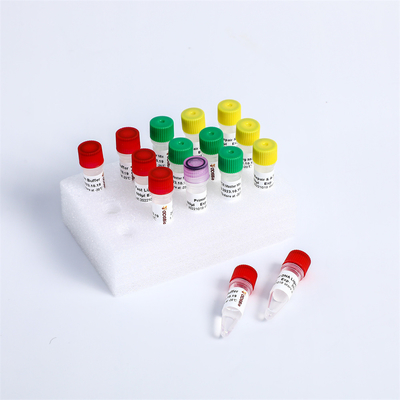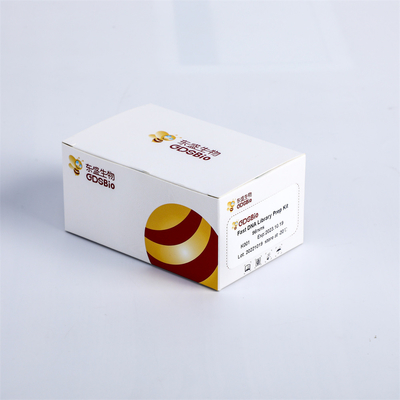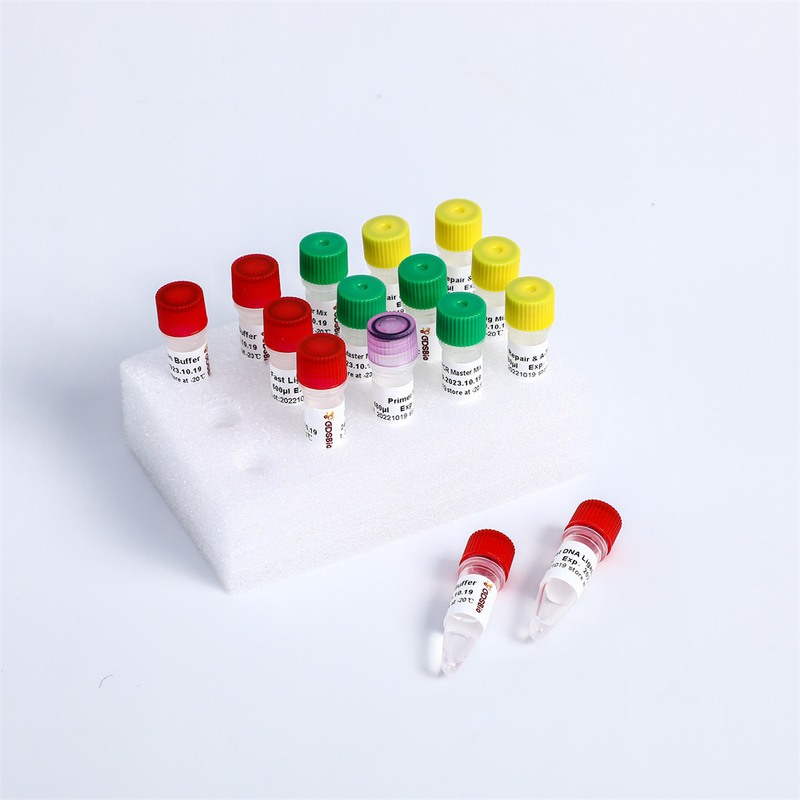Fast DNA Library Prep Kit V2 K001S-A, K001S-B
Product Details:
| Place of Origin: | China |
| Brand Name: | GDSBio |
| Certification: | ISO9001, ISO13485 |
| Model Number: | K001S-A, K001S-B |
Payment & Shipping Terms:
| Minimum Order Quantity: | 1 kit |
|---|---|
| Packaging Details: | small package or bulk distribute or OEM |
| Delivery Time: | 8 work days |
| Payment Terms: | L/C, D/A, D/P, T/T, Western Union, MoneyGram |
| Supply Ability: | 1000 Kits per Day |
|
Detail Information |
|||
| Stock: | Yes | Cat. No.: | K001S-A, K001S-B |
|---|---|---|---|
| Specification: | K001S-A/24 Rxns; K001S-B/96 Rxns; Sample Sack/ 6 Rxns | Appearance: | Complete, No Damage |
| Library Type: | DNA | Sequencing Platform: | Illumina |
| Logo Printing: | With Logo Printing | Transport Package: | Packing |
| Production Capacity: | 1000 Kits Per Day | Storage Conditions: | -20°C, With A Validity Period Of 12 Months. |
| High Light: | GDSBio Disposable Virus Sampling Tube,Class I Disposable Virus Sampling Tube,100% Nylon virus sampling tube |
||
Product Description
Fast DNA Library Prep Kit V2
【Product Name】
Fast DNA Library Prep Kit V2
【Cat. No./Spec.】
K001S-A/24 rxns; K001S-B/96 rxns; sample sack/ 6 rxns
【Product Description】
Aiming at Illumina high-throughput sequencing platform, this kit provides a convenient and universal DNA library construction scheme in one tube. It combines end repair and A-Tailing into one step, greatly shortening the time of library construction and reducing the error caused by tedious steps. The end preparation, adapter ligation, amplification and purification of the fragmented double-stranded DNA can be performed within about 2 hours. Complete library quantification can be performed by dsDNA fluorescent dye method (e.g., Thermo Qubit Flex Fluorometer) or absolute quantification PCR after diluting the library to an appropriate concentration.
【Sample Type】
| Application | Sample Type | Recommended Amount |
| Whole genome sequencing | High quality complex genomes | 50ng-1μg |
| Target capture sequencing of whole exome | High quality complex genomes | 10ng-1μg |
| Target capture sequencing of whole genome | FFPE DNA | ≥50ng |
| Target capture sequencing of whole genome | cfDNA/ctDNA | ≥100pg |
| Whole genome sequencing | Microbial genome | 1ng-1μg |
| Whole genome sequencing(PCR-free) | High quality DNA |
≥50ng (no size selection) ≥200ng (size selection) |
| ChIP-Seq | ChIP DNA | ≥100pg |
| Targeted sequencing | Amplicon | ≥100pg |
【Storage Condition & Shelf Life】
All reagents should be stored at -20°C. Ligation Buffer is normal for crystals to precipitate at low temperatures, it should be balanced to room temperature before use. The product is valid for 12 months.
【Components】
| Component | 24 rxns | 96 rxns |
| End Repair & A-Tailing Enzyme Mix | 120 μl | 2×240 μl |
| End Repair & A-Tailing Buffer | 240 μl | 2×480 μl |
| Fast DNA Ligase | 120 μl | 2×240 μl |
| Fast Ligation Buffer | 600 μl | 4×600 μl |
| 2× HIFI Library PCR Master Mix | 600 μl | 4×600 μl |
| Primer Mix* | 120 μl | 480 μl |
* If there are more than one sample, #K002 and #K003 adapter primer mix is recommended. This kit provides a set of primers with index.
Note:recommended selection beads: #NC1011 GDSPure DNA Selection Magbeads or AMPure XP beads.
【Notes】
1. We offer two types of Universal Adapter primers set (GDS Adapter, #K002 and #K003, purchased separately), but customers can also choose from other manufacturers or synthesize their own Adapter for the Illumina sequencing platform. Too much Adapter will lead to the formation of Adapter dimer, and insufficient Adapter will lead to low library output. Therefore, appropriate Adapter concentration determines the concentration and quality of library. The recommended adapter concentrations for different amounts of DNA input are shown in the following table:
Table 1 Recommended Use Concentrations of Adapter
| DNA Input | Recommended Conc. for Adapter | Adapter:Insert Mole Ratio* | GDS Adapter Dilution Degrees |
| 1μg | 10μM | 10:1 | No dilution |
| 500ng | 10μM | 20:1 | No dilution |
| 250ng | 10μM | 40:1 | No dilution |
| 100ng | 7.5μM | 100:1 | 3:4 |
| 50ng | 5μM | 200:1 | 1:2 |
| 25ng | 2.5μM | 200:1 | 1:4 |
| 1ng | 1μM | 200:1 | 1:10 |
* Adapter:Insert mole ratio refers to the ratio of the Adapter molar number from other sources to the Input DNA molar number, which can be roughly calculated by referring to the following formula:
Input DNA number (pmol)≈Input DNA mass (ng)/[0.66×Input DNA average length (bp)]
*The quality and concentration of the Adapter greatly affect the output of the library, especially for low input libraries. The Adapter from a high-quality source should be selected and diluted to an appropriate concentration with 0.1×TE before ligation. For immediate use, ensure that each sample addition is a fixed 5 μl, avoid sample addition errors, and try to avoid repeated freeze-thaw.
2. The enzyme used in 2× HIFI Library PCR Master Mix is a B family DNA polymerase, which has 5 '-3' polymerase and 3 '-5' exonuclease activities, but lacks 5 '-3' exonuclease activities. It has high fidelity and homogeneity, and strong sustainable synthesis ability. Strict control of the number of amplification cycles is particularly important for library output. The following table shows the recommended number of amplification cycles corresponding to different amounts of DNA input:
Table 2 Recommended Number of Amplification Cycles Corresponding to Different Sample Inputs
| Input DNA | Recommended Number of Amplification Cycles | |
| 100ng Library | 1μg Library | |
| 1μg | 0 | 2-5 |
| 500ng | 0 | 2-5 |
| 250ng | 1-3 | 5-7 |
| 100ng | 2-4 | 6-8 |
| 50ng | 4-6 | 8-10 |
| 25ng | 5-7 | 9-12 |
| 10ng | 7-9 | 11-13 |
| 5ng | 9-11 | 13-14 |
| 2.5ng | 10-12 | 14-16 |
| 1ng | 11-13 | 15-17 |
Note: 1. The above table shows the test results using 150bp standard DNA, which is for reference only.
2. If incomplete connectors are used, a minimum number of cycles (1-3) should be amplified to obtain a complete library.
3. If the quality of the input DNA is poor, or the size selection is carried out during the library construction, the number of amplification cycles should be appropriately increased.
【Standard Library Construction Process】
End Repair
Note: If the fragmented DNA exceeds 45 μl before this step, or the buffer is incompatible with the end repair buffer, a magnetic bead purification should be performed first.
1. Prepare the following reaction in a 200 μl PCR tube:
| Reagents | Volume |
| Fragmented DNA | Variable |
| End Repair & A-Tailing Enzyme Mix | 5 μl |
| End Repair & A-Tailing Buffer | 10 μl |
| ddH2O | To 65 μl |
2. Vortex gently and spin down briefly to mix well, centrifuge briefly and collect all the liquid to the bottom of the tube.
3. Perform the following reaction in a thermal cycler:
| Temperature | Time |
| 20°C | 15min |
| 65°C | 15min |
| 4°C | ∞ |
Adapter Ligation
1. Proceed with the ligation reaction as soon as possible after end preparation.
2. Dilute the adapter according to Table 1.
3. Prepare the following reaction system:
| Reagents | Volume |
| End repair and A-Tailing products | 65 μl |
| Fast Ligation Buffer | 25 μl |
| Fast DNA Ligase | 5 μl |
| Adapter X | 5 μl |
| Total | 100 μl |
4. Vortex gently and spin down briefly to mix well, centrifuge briefly and collect all the liquid to the bottom of the tube.
5. Perform the following reaction in a thermal cycler:
| Temperature | Time |
| 20°C | 15min |
| 4°C | ∞ |
Recommended Solution for PCR Cleanup/Size Selection (the specific magnetic bead volume should be adjusted according to the actual sample size)
1. Prepare 100 μl ligation products into an appropriate centrifuge tube.
2. Add 100 μl of resuspended DNA selection magnetic beads to the sample. Gently blow with a pipette for 10 times (or vortex for 30 s). Incubate samples for 5 min at room temperature.
3. Place the tube on an appropriate magnetic rack to separate the beads from the supernatant. When the solution is clear, carefully remove and discard the supernatant with a pipette (do not discard beads).
4. Add 200 μl of 80% freshly prepared ethanol to the tube while in the magnetic rack. Incubate at room temperature for 30 s, and then carefully remove and discard the supernatant (do not disturb beads).
5. Repeat Step 4 once for a total of two washes.
Note: Be sure to remove all visible liquid after the second wash.
6. Air dry the beads until the surface of the magnetic beads has no obvious gloss while the tube is on the magnetic rack with the lid open.
Note: Do not overdry the beads, this may result in lower recovery of DNA. When the beads start to crack, they are too dry.
7. Remove the tube from the magnetic rack. Add 22 μl elution buffer (10mM Tris-HCl, pH8.0-8.5) to the tube. Mix well by pipetting up and down at least 10 times or on a vortex mixer for 30 s. Incubate for 3-5 min at room temperature.
8. Place the tube on the magnetic rack. After 5 min (or when the solution is clear), transfer 20 μl supernatant to a new tube. The selection is completed, and the selected DNA can be used for subsequent experiments or stored at -20°C for a long time.
Library Amplification
1. Prepare the following reaction in a 200 μl PCR tube:
| Reagents | Volume |
| Ligation products after cleanup or size selection | 20 μl |
| 2× HIFI Library PCR Master Mix | 25 μl |
| Primer mix | 5 μl |
| Total | 50 μl |
2. Vortex gently and spin down briefly to mix well, centrifuge briefly and collect all the liquid to the bottom of the tube.
3. Perform the following reaction in a thermal cycler:
| Temperature | Time | Cycle Number |
| 95°C | 3min | 1 |
| 98°C | 20sec |
Select appropriate number of cycles according to Table 2 |
| 60°C | 15sec | |
| 72°C | 30sec | |
| 72°C | 5min | 1 |
| 4°C | ∞ | - |
Recommended Solution for PCR Cleanup/Size Selection (the specific magnetic bead volume should be adjusted according to the actual sample size)
1. Prepare 50 μl ligation products into an appropriate centrifuge tube.
2. Add 45 μl of resuspended DNA selection magnetic beads to the sample. Gently blow with a pipette for 10 times (or vortex for 30 s). Incubate samples for 5 min at room temperature.
3. Place the tube on an appropriate magnetic rack to separate the beads from the supernatant. When the solution is clear, carefully remove and discard the supernatant with a pipette (do not discard beads).
4. Add 200 μl of 80% freshly prepared ethanol to the tube while in the magnetic rack. Incubate at room temperature for 30 s, and then carefully remove and discard the supernatant (do not disturb beads).
5. Repeat Step 4 once for a total of two washes.
Note: Be sure to remove all visible liquid after the second wash.
6. Air dry the beads until the surface of the magnetic beads has no obvious gloss while the tube is on the magnetic rack with the lid open.
Note: Do not overdry the beads, this may result in lower recovery of DNA. When the beads start to crack, they are too dry.
7. Remove the tube from the magnetic rack. Add 22 μl elution buffer (10mM Tris-HCl, pH8.0-8.5) to the tube. Mix well by pipetting up and down at least 10 times or on a vortex mixer for 30 s. Incubate for 3-5 min at room temperature.
8. Place the tube on the magnetic rack. After 5 min (or when the solution is clear), transfer 20 μl supernatant to a new tube. The selection is completed, and the selected DNA can be stored at 2-8°C for 1-2 weeks or stored at -20°C for a long time.
【Appendix】Recommended Scheme for Double-Sided Selection
If double-round selection is required, we provide the following scheme to select the appropriate magnetic bead volume according to the expected library size. The size selection can be performed before end repair or after amplification. Two or more double-round selection will greatly reduce the library yield.
Fill the library volume in the table below to 100 μl. Select the volume of magnetic beads in two rounds according to the expected library size. And carry out the selection operation according to the following instructions.
Table 3 Recommended Amount of Magnetic Beads for Double-Round Selection
| Expected Library Size | 150bp | 200bp | 250bp | 300bp | 400bp | 500bp | 600bp | 700bp | |
| Volume of Beads(μl) | Round 1 | 100 | 90 | 80 | 70 | 60 | 55 | 50 | 45 |
| Round 2 | 30 | 20 | 20 | 20 | 20 | 15 | 15 | 15 | |
1. Fill the library volume to 100 μl in a 200μl PCR tube and labeled as A. Add a certain volume of Magnetic beads according to the Table 3 (Round 1) to the tube A. Gently blow with a pipette for 30 s. Incubate samples for 5 min at room temperature.
2. Place the tube A on an appropriate magnetic rack to separate the beads from the supernatant. When the solution is clear, carefully remove the supernatant to a new tube and label it as B. Discard beads.
3. Add a certain volume of Magnetic beads according to the Table 3 (Round 2) to the tube B. Gently blow with a pipette for 30 s. Incubate samples for 5 min at room temperature. Place the tube B on magnetic rack. When the solution is clear, carefully remove and discard the supernatant.
4. Add 200 μl of 80% freshly prepared ethanol to the tube B while in the magnetic rack. Incubate at room temperature for 30 s, and then carefully remove and discard the supernatant (do not disturb beads).
5. Repeat Step 6 once for a total of two washes.
Note: Be sure to remove all visible liquid after the second wash.
6. Air dry the beads until the surface of the magnetic beads has no obvious gloss while the tube B is on the magnetic rack with the lid open.
Note: Do not overdry the beads, this may result in lower recovery of DNA. When the beads start to crack, they are too dry.
7. Remove the tube B from the magnetic rack. Add 22 μl elution buffer to the tube. Mix well by pipetting up and down at least 10 times or on a vortex mixer for 30 s. Incubate for 3-5 min at room temperature.
Note: If targeted capture will not be performed, add elution buffer (10mM Tris-HCl, ph 8.0-8.5) for elution. Otherwise, sterilized ultrapure water should be used for elution.
- Place tube B on the magnetic rack. Transfer 20 μl supernatant to a new tube.
For Research Use Only
![]()






